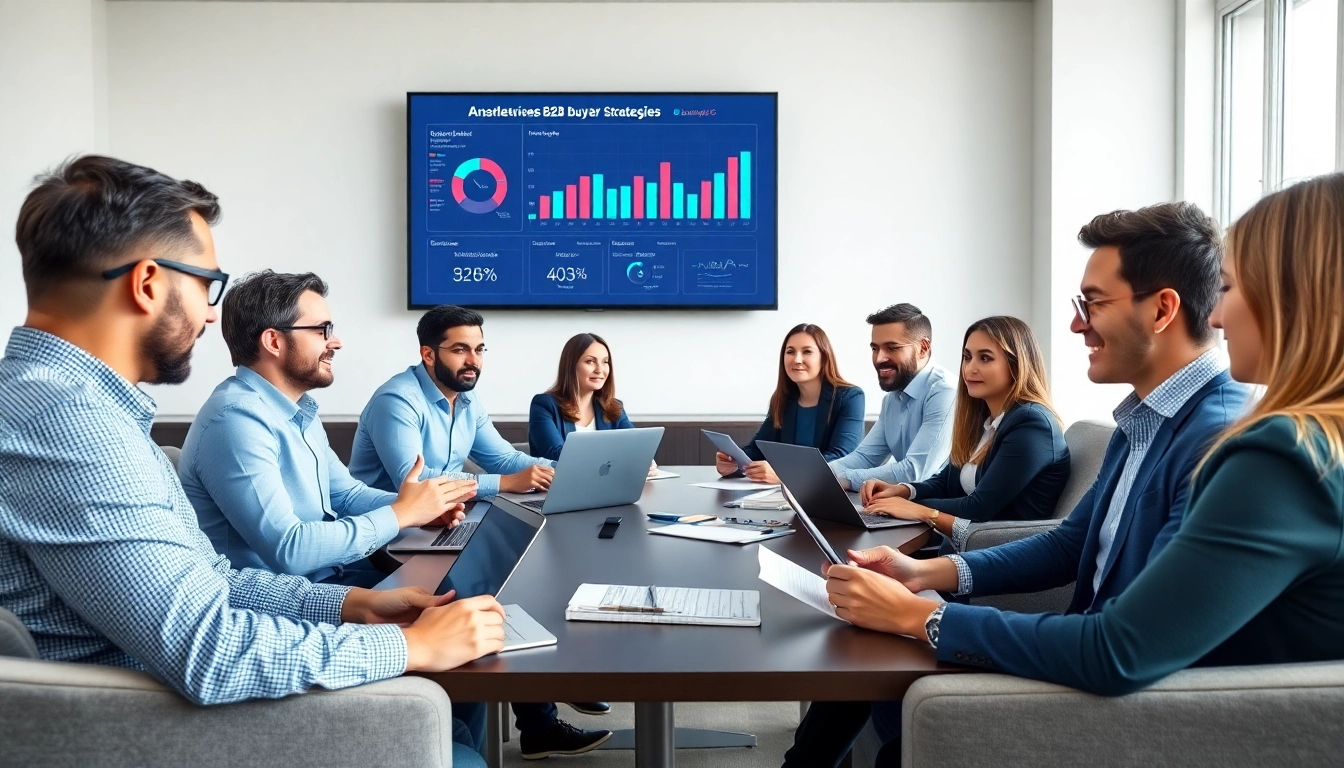Understanding the B2b Buyer
In today’s fast-paced digital marketplace, the B2b buyer has emerged as a complex individual whose purchasing behavior significantly influences business success. These buyers are not just decision-makers; they are strategic thinkers actively researching products and services that resonate with their organizational needs. To engage effectively with this audience, it’s essential to understand their characteristics, the challenges they encounter, and the significance of digital interaction in the buying process.
Characteristics of the B2b Buyer
The modern B2b buyer is characterized by several defining traits that guide their purchasing decisions:
- Informed Decision-Makers: B2b buyers increasingly conduct thorough research before making any purchase. Data suggests that over 50% of buyers make daily digital purchases, showcasing their reliance on online resources.
- Value Seekers: They prioritize reliable products and services that contribute tangible value to their organizations. Factors such as uptime, customer service, and ROI are critical.
- Digital Natives: With the rise of digital platforms, a significant number of B2b buyers are accustomed to virtual interactions. This trend highlights their preference for engaging with businesses via digital channels, often seeking rep-free sales experiences.
- Collaborative Approach: Many B2b buyers work in teams to evaluate options. This often means a longer decision-making process involving multiple stakeholders whose opinions must be aligned.
Common Challenges Faced by B2b Buyers
Despite their familiarity with the purchasing process, B2b buyers face several challenges:
- Information Overload: The abundance of data available can leave B2b buyers overwhelmed. Distinguishing high-quality, relevant information from the noise is a significant hurdle.
- Time Constraints: Balancing daily responsibilities while researching solutions can limit the time available for thorough market exploration.
- Complex Decision-Making Processes: Engagement with multiple stakeholders can complicate the decision-making process, often resulting in delays and misalignment.
- Pressure for Immediate Results: With organizations looking for quick solutions, B2b buyers often face pressure to demonstrate ROI swiftly, influencing their choice of vendor.
Importance of Digital Interaction for B2b Buyers
Digital interaction is pivotal in facilitating the B2b buying journey. The following points highlight its importance:
- Access to Information: Online channels provide buyers with immediate access to product specifications, customer reviews, and market comparisons, enhancing their ability to make informed decisions.
- Efficiency: Digital tools streamline the research process, allowing buyers to vet options rapidly, communicate with vendors, and finalize purchases without unnecessary delays.
- Enhanced Customer Experience: Personalized digital experiences, tailored content, and proactive customer service contribute to smoother transactions, fostering buyer loyalty.
Stages of the B2b Buying Journey
Understanding the stages of the B2b buying journey is essential for engaging buyers effectively. This journey typically consists of three key stages: Awareness, Consideration, and Decision.
Aware Stage: How B2b Buyers Discover Solutions
In the awareness stage, B2b buyers identify their needs and seek solutions, often driven by pain points within their organizations. Effective strategies to engage at this stage include:
- Educational Content: Providing whitepapers, blog posts, and webinars that educate buyers about their challenges and potential solutions can capture their attention.
- Targeted Advertising: Utilizing digital marketing strategies such as SEO and pay-per-click campaigns can enhance visibility and attract buyers searching for solutions.
- Industry Engagement: Participating in industry events and online forums can help brands build awareness and establish themselves as thought leaders.
Consideration Stage: Evaluating Options as a B2b Buyer
During the consideration stage, B2b buyers compare various solutions to determine which best aligns with their requirements. It’s critical to facilitate this process through:
- Comparative Analysis Tools: Offering tools that allow buyers to compare different products based on features, pricing, and reviews can enhance decision-making.
- Testimonials and Case Studies: Sharing success stories and testimonials can build credibility and demonstrate real-world applications of products.
- Engaging Sales Support: Providing easy access to knowledgeable sales representatives who can answer questions and provide insights adds value to the buyer’s experience.
Decision Stage: Converting Interest into Purchase as a B2b Buyer
In the final decision stage, buyers are ready to finalize their purchases. Strategies to convert interest into action include:
- Streamlining the Purchase Process: Ensuring that the buying process is straightforward—offering easy navigation through purchase portals and clear checkout processes.
- Incentives and Promotions: Offering limited-time promotions or discounts can encourage buyers to act quickly.
- Post-Purchase Follow-Up: Engaging with buyers after the sale helps build relationships and assurance, paving the way for future purchases.
Strategies to Effectively Engage B2b Buyers
To successfully engage B2b buyers, companies must implement targeted strategies tailored to this audience’s preferences. Here are some effective approaches:
Content Marketing for the B2b Buyer
Content marketing remains a cornerstone of B2b engagement. Strategically crafting content that addresses specific buyer personas can effectively guide them through their journey.
- Educational Resources: High-quality videos, informative articles, and insightful infographics can capture buyer interest.
- Thought Leadership: Establishing authority in your industry through expert opinions and research can enhance trust.
- Targeted Content Distribution: Utilizing data-driven insights to identify where your audience engages most can ensure content reaches the right eyes.
Leveraging Social Proof for B2b Buyer Confidence
Social proof greatly influences the B2b buying decision. Building trust through these elements can promote engagement:
- Customer Reviews: Displaying positive feedback prominently can alleviate buyer anxiety and showcase product reliability.
- Case Studies and Success Stories: Real-life examples of product implementation can inspire confidence among potential buyers.
- Industry Awards and Accolades: Highlighting recognition received indicates credibility and reliability, reinforcing decision-making.
Building Relationships with B2b Buyers through Personalization
Personalization enhances the buyer experience significantly. Tailored interactions can include:
- Customized Recommendations: Using buyer data to suggest products aligned with their needs fosters a more engaging experience.
- Adaptive Content Strategies: Adjusting content based on user behavior and preferences can maximize engagement and relevance.
- Proactive Communication: Regularly checking in with potential buyers via newsletters and tailored offers can keep your brand top of mind.
Common Mistakes in B2b Buyer Engagement
Even experienced marketers can fall into traps when engaging with B2b buyers. Avoiding common mistakes can enhance overall effectiveness:
Ignoring the Research Phase of B2b Buyers
Overlooking the research phase can result in lost opportunities. To combat this:
- Facilitate Access to Information: Offering comprehensive resources can help buyers during their research.
- Engage with Content Marketing: Regular content updates can keep your audience informed and engaged.
Underestimating the Power of Referrals for B2b Buyers
Referrals and word-of-mouth recommendations are potent tools for buyers. Encouraging and managing referrals can be accomplished through:
- Creating Referral Programs: Implementing an incentive-driven referral program can motivate satisfied customers to share their experiences.
- Engaging with Existing Clients: Happy customers are often willing to share their experiences; leveraging these connections can amplify outreach.
Overlooking Post-Purchase Engagement with B2b Buyers
Failing to maintain a relationship post-purchase can hinder future sales. Follow-up strategies to keep buyers engaged may include:
- Customer Satisfaction Surveys: Regularly gauging customer satisfaction reveals insights for improvement and increases engagement.
- Continuous Communication: Keeping in touch through personalized emails and regular updates can solidify long-term relationships.
Measuring Success in Capturing B2b Buyers
To optimize buyer engagement, establishing key performance indicators (KPIs) is vital. Monitoring success involves:
Key Performance Indicators for B2b Buyer Engagement
Identifying relevant KPIs helps assess engagement strategies effectiveness. Consider tracking:
- Engagement Metrics: Including website traffic, content shares, and lead generation gives an insight into buyer interactions.
- Conversion Rates: Monitoring the percentage of leads converting into customers highlights the effectiveness of your engagement strategies.
- Customer Retention Rates: Understanding how often buyers return helps assess satisfaction and service performance.
Feedback Loops: Learning from B2b Buyers
Creating feedback loops with buyers allows for continuous improvement. Strategies to encourage feedback include:
- Active Listening: Taking time to listen to buyer experiences improves service and enhances product offerings.
- Incorporating Feedback: Actively utilizing feedback to modify processes demonstrates responsiveness to buyer expectations.
Adapting Strategies Based on B2b Buyer Behavior
Market conditions and buyer preferences evolve. Adapting strategies involves:
- Regular Analysis: Continually analyzing buyer behavior and market trends can inform necessary adjustments to your approach.
- A/B Testing: Experimenting with different engagement strategies can reveal effective tactics to retain and convert B2b buyers.



